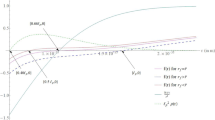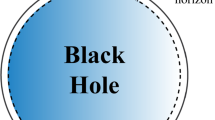Abstract
A presentation of the Vaidya type Schwarzschild-like black holes with flat, AdS and dS asymptotics in 4-dimensional general relativity in the form of a pointlike mass is given. True singularities are described by making the use of the Dirac \(\delta\)-function in a non-contradictory way. The results essentially generalize previous derivations where the usual Schwarzschild black hole solution is represented in the form of a point particle. The field-theoretical formulation of general relativity, which is equivalent to its standard geometrical formulation, is applied as an alternative mathematical formalism. Then perturbations on a given background are considered as dynamical fields propagating in a given (fixed) spacetime. The energy (mass) distribution of such field configurations is just represented as a point mass. The new description of black holes’ structure can be useful in explaining and understanding their features and can be applied in calculations with black hole models. A possibility of application of the field-theoretical formalism in studying the regular black hole solutions is discussed.
Similar content being viewed by others
Data Availability Statement
This manuscript has no associated data or the data will not be deposited. [Authors’ comment: All calculations have been presented directly in the text.]
Notes
References
R. Arnowitt, S. Deser, C.W. Misner, Finite self-energy of classical point particles. Phys. Rev. Lett. 4(7), 375 (1960)
R. Arnowitt, S. Deser, C.W. Misner, Gravitational-electromagnetic coupling and the classical self-energy problem. Phys. Rev. 120(1), 313 (1960)
F.R. Tangherlini, Nonclassical structure of the energy-momentum tensor of a point mass source for the Schwarzschild field. Phys. Rev. Lett. 6(3), 147 (1961)
P.E. Parker, Distributional geometry. J. Math. Phys. 20(7), 1423–1426 (1979)
A.H. Taub, Space-times with distribution valued curvature tensors. J. Math. Phys. 21(6), 1423–1431 (1980)
C.K. Raju, Junction conditions in general relativity. J. Phys. A: Math. Gen. 15(6), 1785 (1982)
J.F. Colombeau, A multiplication of distributions. J. Math. Anal. Appl. 94(1), 96–115 (1983)
R. Geroch, J. Traschen, Strings and other distributional sources in general relativity. Phys. Rev. D 36(4), 1017 (1987)
H. Balasin, H. Nachbagauer, Distributional energy-momentum tensor of the Kerr–Newman spacetime family. Class. Quantum Grav. 11(6), 1453 (1994)
C.J.S. Clarke, J.A. Vickers, J.P. Wilson, Generalized functions and distributional curvature of cosmic strings. Class. Quantum Grav. 13(9), 2485 (1996)
J.P. Wilson, Distributional curvature of time dependent cosmic strings. Class. Quantum Grav. 14(12), 3337 (1997)
J.A. Vickers, J.P. Wilson, Invariance of the distributional curvature of the cone under smooth diffeomorphisms. Class. Quantum Grav. 16(2), 579 (1999)
N.R. Pantoja, H. Rago, Distributional sources in general relativity: two point-like examples revisited. J. Mod. Phys. D 11(9), 1479–1499 (2002)
M. Melis, S. Mignemi, Two-dimensional static black holes with pointlike sources. Gen. Relat. Grav. 37(July 06), 1313–1322 (2005)
M. Cadoni, S. Mignemi, Two-dimensional description of \(D\)-dimensional static black holes with pointlike source. Mod. Phys. Lett. A 20(38), 2919–2924 (2005)
A.P. Lundgren, B.S. Schmekel, J.W. York Jr., Self-renormalization of the classical quasilocal energy. Phys. Rev. D 75(8), 084026 (2007)
I.I. Bulygin, M.V. Sazhin, O.S. Sazhina, Theory of gravitational lensing on a curved cosmic string. Eur. Phys. J. C 83(9), 844 (2023)
D.D. Sokolov, A.A. Starobinsky, The structure of the curvature tensor at conical singularities. Sov. Phys. Doklady 22, 312–314 (1977)
Ch.W. Misner, K.S. Thorne, J.A. Wheeler, Gravitation (W. H. Freeman, San Francisco, 1973)
L. Bel, Schwarzschild singularity. J. Math. Phys. 10(8), 1501–1503 (1969)
T. Kawai, E. Sakane, Distributional energy-momentum densities of Schwarzschild space-time. Prog. Theor. Phys. 98(1), 69–86 (1997)
J.M. Heinzle, R. Steinbauer, Remarks on the distributional Schwarzschild geometry. J. Math. Phys. 43(3), 1493–1508 (2002)
M.O. Katanaev, Point massive particle in general relativity. Gen. Relat. Grav. 45(July 24), 1861–1875 (2013)
P.P. Fiziev, The era of gravitational astronomy and gravitational field of non-rotating single point particle in general relativity. Phys. Part. Nuclei 50(6), 944–972 (2019)
A.N. Petrov, J.V. Narlikar, The energy distribution for a spherically symmetric isolated system in general relativity. Found. Phys. 26(9), 1201–1229 (1996)
A.N. Petrov, The Schwarzschild black hole as a point particle. Found. Phys. Lett. 18(10), 477–489 (2005)
A.N. Petrov, A point mass and continuous collapse to a point mass in general relativity. Gen. Relat. Grav. 50(1), 6 (2018)
L.P. Grishchuk, A.N. Petrov, A.D. Popova, Exact theory of the (Einstein) gravitational field in an arbitrary background space-time. Commun. Math. Phys. 94(9), 379–396 (1984)
A.D. Popova, A.N. Petrov, The dynamic theories on a fixed background in gravitation. Int. J. Mod. Phys. A 3(11), 2651–2679 (1988)
L.P. Grishchuk, A.N. Petrov, The Hamiltonian description of the gravitational field and gauge symmertries. Sov. Phys.: JETP 65(1), 5 (1987)
A.N. Petrov, A note on the Deser–Tekin charges. Class. Quantum Grav. 22(16), L83 (2005)
A.N. Petrov, S.M. Kopeikin, R.R. Lompay, B. Tekin, Metric Theories of Gravity: Perturbations and Conservation Laws, volume 38 of De Gruyter Studies in Mathematical Physics. De Gruyter, 4 (2017)
A.N. Petrov, J.B. Pitts, The field-theoretic approach in general relativity and other metric theories: a review. Space Time Fundam Interact 4, 66–124 (2019)
J.D. Brown, J.W. York, Quasilocal energy and conserved charges derived from the gravitational action. Phys. Rev. D 47(4), 1407 (1993)
D. Lovelock, The Einstein tensor and its generalizations. J. Math. Phys. 12(3), 498–501 (1971)
A.N. Petrov, Field-theoretical construction of currents and superpotentials in Lovelock gravity. Class. Quantum Grav. 36(23), 235021 (2019)
A.N. Petrov, Conserved quantities for black hole solutions in pure Lovelock gravity. Class. Quantum Grav. 38(15), 155017 (2021)
N. Dadhich, S.G. Ghosh, S. Jhingan, Gravitational collapse in pure Lovelock gravity in higher dimensions. Phys Rev. D 88(8), 084024 (2013)
J. Kastikainen, Quasi-local energy and ADM mass in pure Lovelock gravity. Class. Quantum Grav. 37(2), 025001 (2020)
R.-G. Cai, N. Ohta, Black holes in pure lovelock gravities. Phys Rev. D 74(6), 064001 (2006)
R.-G. Cai, L.-M. Cao, Y.-P. Hu, S.P. Kim, Generalized Vaidya spacetime in lovelock gravity and thermodynamics on apparent horizon. Phys. Rev. D 78(12), 124012 (2008)
T. Damour, P. Jaranowsk, G. Schäfer, Dimensional regularization of the gravitational interaction of point masses. Phys. Lett. B 513(1–2), 147–155 (2001)
L. Blanchet, Gravitational radiation from post-Newtonian sources and inspiralling compact binaries. Living Rev. Relat. 17, 2 (2014)
J.B. Pitts, W.C. Schieve, Null cones and Einstein’s equations in Minkowski spacetime. Found. Phys. 34(2), 211–238 (2004)
A.Z. Petrov, Einstein Spaces (Pergamon Press, Oxford, 1969)
A.E. Dominguez, E. Gallo, Radiating black hole solutions in Einstein–Gauss–Bonnet gravity. Phys. Rev. D 73(6), 064018 (2006)
S.W. Hawking, G.F.R. Ellis, The Large Scale Structure of Space–Time (CUP, Cambridge, 1973)
H. Nariai, On some static solutions of Einstein’s gravitational field equations in a spherically symmetric case. Gen. Relat. Grav. 31(6), 951–961 (1999)
H. Nariai, On a new cosmological solution of Einstein’s field equations of gravitation. Gen. Relat. Grav. 31(6), 963–971 (1999)
V. Balasubramanian, J. de Boer, D. Minic, Mass, entropy and holography in asymptotically de Sitter spaces. Phys. Rev. D 65(12), 123508 (2002)
R.-G. Cai, Y.S. Myung, Y.-Z. Zhang, Check of the mass bound conjecture in the de Sitter space. Phys. Rev. D 65(8), 084019 (2002)
I.M. Gelfand, G.E. Shilov, Generalized Functions. Properties and Operations, vol. 1 (Academic Press, New York, 1964)
G.A. Korn, T.A. Korn, Mathematical Handbook for Scientists and Engineers (McGraw-Hill Book Comp, New York, 1968)
P.A. Spirin, Some Mathematical Questions of Theoretical Physics. Part 2. Lectures at Physical Faculty (Moscow University Press, Moscow, 2022). (in Russian)
R. Carballo-Rubio, F. Di Filippo, S. Liberati, C. Pacilio, M. Visser, On the viability of regular black holes. JHEP 2018(07), 023 (2018)
L. Sebastiani, S. Zerbini, Some remarks on non-singular spherically symmetric space–times. Astronomy 1(2), 99–125 (2022)
C. Bambi (ed.), Regular Black Holes: Towards a New Paradigm of Gravitational Collapse (Springer, Singapore, 2023)
D. Malafarina, Semi-classical Dust Collapse and Regular Black Holes. Chapter 12 in book [57] (2023)
Acknowledgements
The author is very grateful to Brian Pitts and George Alekseev for reading the manuscript and useful comments, he also very thanks Aleksei Staroboinsky, Igor Bulygin and Olga Sazhina for the explanation of their articles. The work has been supported by the Interdisciplinary Scientific and Educational School of Moscow University “Fundamental and Applied Space Research”.
Author information
Authors and Affiliations
Corresponding author
Rights and permissions
Springer Nature or its licensor (e.g. a society or other partner) holds exclusive rights to this article under a publishing agreement with the author(s) or other rightsholder(s); author self-archiving of the accepted manuscript version of this article is solely governed by the terms of such publishing agreement and applicable law.
About this article
Cite this article
Petrov, A.N. Black holes of the Vaidya type with flat and (A)dS asymptotics as point particles. Eur. Phys. J. Plus 138, 879 (2023). https://doi.org/10.1140/epjp/s13360-023-04514-z
Received:
Accepted:
Published:
DOI: https://doi.org/10.1140/epjp/s13360-023-04514-z




